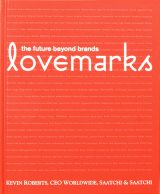Featured Stories
Lovemarks: It’s time to have a tryst with your audience

You may have noticed a few changes in the San Diego Troubadour since the beginning of the year. One is our attempt to branch out beyond San Diego’s music community. “Other Expressions,” which will appear semi-regularly on this page, aims at uncovering stories from the visual arts, dramatic arts, pop culture, and even the business world.
This month we are reviewing a book that is having a major impact on the world of advertising. This is the same world many have glimpsed on the fictionalized hit TV show “Mad Men.” This is also a world that employs more artists, musicians, and creative thinkers than any other single industry in the world. So, like it or not, what happens in the “ad biz” strikes very close to home.
At first blush, many will wonder why artists should read a book written for the business world. After all, isn’t Big Business an anathema to all pure artists everywhere? Doesn’t becoming “commercial” signal an artist’s creative death? While it is a romantic ideal that the arts and business never overlap, and artists remain that group that needs to morally crusade against the business world, the truth is that the arts and business have more in common than either might like to admit.
At the very least, artists need to connect with an audience and sell themselves in order to survive. It would be nice to create art for art’s sake. But, all too often, the artist is selling a product just like the rest of us.
Lovemarks: The future beyond brands was first written in 2005 by Saatchi & Saatchi CEO Kevin Roberts. Considering that Saatchi is one of the largest ad agencies in the world, when Roberts shares his knowledge, we should all definitely listen. Also refreshing is that Roberts represents the post-1960s business exec à la Steve Jobs and Richard Branson. He mixes a solid business sense with an aesthetic that relies on liberal politics, social freedom, and hip, counter-cultural taste. So, bohemians, rest assured. This is not some stuffy old textbook about your father’s balance sheets.
At its heart, Lovemarks proffers that companies need to do the same things that individuals do when building strong friendships and even romantic relationships. The key is to build emotion into the product or as Roberts puts it: “Mystery, sensuality, and intimacy.” Roberts then spends time breaking these three ingredients down into parts while providing examples from Saatchi’s own clientele to underscore his points.
Add to that the additional qualities of authenticity, contemporary relevance, respect, and passion, and you have a recipe book for how to get your customers to fall madly in love with your product, not just once but for a lifetime. In fact, it’s that lifetime love affair that is at the heart of the “lovemarks” concept. Companies are not simply trying to sell products, they are trying to create “loyalty beyond reason,” a relationship with the consumer that will weather decades of marriage.
In a nutshell, Roberts is trying to steer companies away from the number-crunching models that are too often successful. Roberts calls for companies to become “emotional” and begin answering to real consumer needs not the stockholders’ bottom line. As he reminds us: “Lovemarks are owned by the people who love them,” meaning that consumers must feel ownership over the products they buy. Therefore, Roberts discusses a number of instruments by which companies can actually bring the consumer into the research and development of new products and the improvement of existing ones. With the instant communication afforded by the internet, this two-way communication is more possible than ever.
If you’ve ever heard people refer to companies as my companies (i.e., my Padres, my Starbucks, my Jack Daniels), you’ve gotten a glimpse of this phenomenon. If you think of some of the companies and products that help create lifestyles and maintain an almost cult-like following (i.e., Harley-Davidson, Apple, the Fender Stratocaster), then you have an understanding of Lovemarks.
The concept is profound. And, there is a lot that artists, musicians, and writers can learn from a book that was written for business people. Roberts uses many examples that non-business types will relate to such as Nelson Mandela and Putumayo World Music. Since his father-in-law — Don Honeywill — played saxophone on the Beatles “All You Need Is Love” session, Roberts shows his affinity for popular music throughout. Many of the chapters, in fact, are named for songs from the rock n’ roll canon.
My glowing praise for Lovemarks, however, doesn’t mean that the book is beyond criticism. Visually creative, the book relies on different type sizes, colors, and fonts, which often change from paragraph to paragraph. This, for me at least, detracts from the seriousness of the subject matter, rendering Lovemarks more a coffee table curiousity than an academic tome.
The bar for books about advertising was set very high by ad men David Ogilvy and Bill Bernbach during advertising’s creative revolution of the early-1960s. The books by Ogilvy and Bernbach thoroughly dissected their subject matter while providing in-depth studies and examples. In contrast, Lovemarks often hovers on plane with the superficial, with the author saying things like, “Virgin Atlantic? Just ask Ben, my eldest son!” instead of providing hard data as to why Virgin Atlantic is a Lovemark.
Also, the examples are sometimes obscure. For instance, Roberts, who lives in New Zealand, refers to many of that country’s sports teams and local beers as examples. It would serve the American reader better if an American edition referred to local products that Americans consider Lovemarks. So, instead of citing the All Blacks rugby team, perhaps Roberts would ring truer with an American audience by citing the New York Yankees or the Green Bay Packers.
Still, I highly recommend Lovemarks: A future beyond brands for anyone who has ever worried about connecting with an audience. In a world where everything has turned into a commodity, it will take special efforts to re-insert “the human” back into the equation.
If you are interested, there is an online resource (www.lovemarks.com) that provides further examples and tools not found in the book itself. The website is Roberts’ own attempt to connect with his audience, thus practicing exactly what he has preached.






